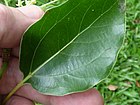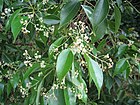Note: This is a project under development. The articles on this wiki are just being initiated and broadly incomplete. You can Help creating new pages.
Difference between revisions of "Cinnamomum camphora - Karpura"
(Created page with "thumb|right|''Karpura'', '' Cinnamomum camphora'' '''Karpura''', Cinnamomum...") |
(→Identification) |
||
| (14 intermediate revisions by 2 users not shown) | |||
| Line 1: | Line 1: | ||
[[File:Starr-180406-0770-Cinnamomum camphora-leaves-DOFAW Arboretum Hilo-Hawaii (39560058730).jpg|thumb|right|''Karpura'', '' Cinnamomum camphora'']] | [[File:Starr-180406-0770-Cinnamomum camphora-leaves-DOFAW Arboretum Hilo-Hawaii (39560058730).jpg|thumb|right|''Karpura'', '' Cinnamomum camphora'']] | ||
| − | ''' | + | '''Cinnamomum camphora''' is a relatively fast-growing, evergreen tree. it is usually grows from 10 - 15 metres tall but can reach 40 metres. The plant is grown commercially in China and Japan as a medicinal tree and also for its essential oil, though most camphor oil on the market nowadays is produced synthetically. |
| − | |||
==Uses== | ==Uses== | ||
| − | {{Uses| | + | {{Uses|Indigestion}}, {{Uses|Inflammation}}, {{Uses|Decongestant}}, {{Uses|Cold and cough}}, {{Uses|Aphrodisiac}}, {{Uses|Arthritis}} |
<ref name="Uses"/> | <ref name="Uses"/> | ||
==Parts Used== | ==Parts Used== | ||
| − | {{Parts Used| | + | {{Parts Used|Leaves}} |
| + | |||
==Chemical Composition== | ==Chemical Composition== | ||
| + | The plant contains a volatile oil comprising camphor, safrole, linalool, eugenol. | ||
| + | <ref name="Chemical composition"/> | ||
==Common names== | ==Common names== | ||
| − | {{Common names|kn= | + | {{Common names|kn=Karpoora, Paccakarpura|ml=Kutakkarpuram, Karpooram|sa=Candraprabha, Himavaluka, Karpurah, Gandhadravya|ta=Pachai Karpooram, Karpuram|te=Candramu, gamburam, Ghanasaramu, Kappuramu, karpuramupacha, Karpooram|hi=Kapur|en=Camphor tree}} |
<ref name="Common names"/> | <ref name="Common names"/> | ||
| Line 35: | Line 37: | ||
==Identification== | ==Identification== | ||
===Leaf=== | ===Leaf=== | ||
| − | {{Leaf|Simple| | + | {{Leaf|Simple|Alternate|Leaves spirally arranged, glabrous, chartaceous to sub-coriaceous, ovate-elliptic to elliptic to subovate-elliptic.}}<ref name="Leaf"/> |
===Flower=== | ===Flower=== | ||
| − | {{Flower|Bisexual| | + | {{Flower|Bisexual|Axillary panicles|Greenish white||Panicles axillary, slender, glabrous, many-flowered, up to 10 cm long with few short branches.}} |
===Fruit=== | ===Fruit=== | ||
| − | {{Fruit|A berry|5-10 mm in diameter|Fruit globose, slightly fleshy, 5-10 mm in diameter, seated on a shallow | + | {{Fruit|A berry|5-10 mm in diameter|Fruit globose, slightly fleshy, 5-10 mm in diameter, seated on a shallow.||}} |
===Other features=== | ===Other features=== | ||
| Line 54: | Line 56: | ||
==How to plant/cultivate== | ==How to plant/cultivate== | ||
| − | + | Seed - the seed has a short viability and is best sown as soon as it is ripe. Remove the fruit pulp since this can inhibit germination. Germination can take 1 - 6 months at 20°c | |
| − | = | + | <ref name="Cultivation details"/> |
| − | |||
| − | |||
| − | |||
| − | |||
| − | |||
==Commonly seen growing in areas== | ==Commonly seen growing in areas== | ||
| Line 78: | Line 75: | ||
<references> | <references> | ||
| − | <ref name="Uses">[https://www.planetayurveda.com/library/karpura-cinnamomum-camphora " | + | <ref name="Uses">[https://www.planetayurveda.com/library/karpura-cinnamomum-camphora Uses]</ref> |
| + | |||
| + | <ref name="Leaf">[http://FLOWERING PLANTS OF KERALA VER.2, N. Sasidharan BOTANIC DESCRIPTION]</ref> | ||
| + | <ref name="Chemical composition">[http://gbpihedenvis.nic.in/PDFs/Glossary_Medicinal_Plants_Springer.pdf Chemical composition]</ref> | ||
| − | <ref name=" | + | <ref name="Common names">[http://envis.frlht.org/bot_search Vernacular names]</ref> |
| − | <ref name=" | + | <ref name="Cultivation details">[https://pfaf.org/user/Plant.aspx?LatinName=Cinnamomum+camphora Cultivation details]</ref> |
| Line 87: | Line 87: | ||
==External Links== | ==External Links== | ||
| − | * https://easyayurveda.com/2014/12/08/camphor-benefits-dose-research-side-effects/ | + | * [https://easyayurveda.com/2014/12/08/camphor-benefits-dose-research-side-effects/ Cinnamomum camphora on easyayurveda.com] |
| − | * https://www.ayurtimes.com/cinnamomum-camphora/ | + | * [https://www.ayurtimes.com/cinnamomum-camphora/ Cinnamomum camphora on ayurtimes.com] |
| − | * http://tropical.theferns.info/viewtropical.php?id=Cinnamomum+camphora | + | * [http://tropical.theferns.info/viewtropical.php?id=Cinnamomum+camphora Cinnamomum camphora on theferns.info] |
[[Category:Herbs]] | [[Category:Herbs]] | ||
[[Category:Tree]] | [[Category:Tree]] | ||
| + | [[Category:Ayurvedic herbs that don't have seed photos]] | ||
| + | [[Category:Lauraceae]] | ||
Latest revision as of 18:11, 15 April 2020
Cinnamomum camphora is a relatively fast-growing, evergreen tree. it is usually grows from 10 - 15 metres tall but can reach 40 metres. The plant is grown commercially in China and Japan as a medicinal tree and also for its essential oil, though most camphor oil on the market nowadays is produced synthetically.
Contents
- 1 Uses
- 2 Parts Used
- 3 Chemical Composition
- 4 Common names
- 5 Properties
- 6 Habit
- 7 Identification
- 8 List of Ayurvedic medicine in which the herb is used
- 9 Where to get the saplings
- 10 Mode of Propagation
- 11 How to plant/cultivate
- 12 Commonly seen growing in areas
- 13 Photo Gallery
- 14 References
- 15 External Links
Uses
Indigestion, Inflammation, Decongestant, Cold and cough, Aphrodisiac, Arthritis [1]
Parts Used
Chemical Composition
The plant contains a volatile oil comprising camphor, safrole, linalool, eugenol. [2]
Common names
| Language | Common name |
|---|---|
| Kannada | Karpoora, Paccakarpura |
| Hindi | Kapur |
| Malayalam | Kutakkarpuram, Karpooram |
| Tamil | Pachai Karpooram, Karpuram |
| Telugu | Candramu, gamburam, Ghanasaramu, Kappuramu, karpuramupacha, Karpooram |
| Marathi | NA |
| Gujarathi | NA |
| Punjabi | NA |
| Kashmiri | NA |
| Sanskrit | Candraprabha, Himavaluka, Karpurah, Gandhadravya |
| English | Camphor tree |
Properties
Reference: Dravya - Substance, Rasa - Taste, Guna - Qualities, Veerya - Potency, Vipaka - Post-digesion effect, Karma - Pharmacological activity, Prabhava - Therepeutics.
Dravya
Rasa
Tikta (Bitter), Katu (Pungent), Madhura (Sweet)
Guna
Laghu (Light), Rooksha (Dry)
Veerya
Sheeta (cold)
Vipaka
Katu (Pungent)
Karma
Pitta, Kapha
Prabhava
Habit
Identification
Leaf
| Kind | Shape | Feature |
|---|---|---|
| Simple | Alternate | Leaves spirally arranged, glabrous, chartaceous to sub-coriaceous, ovate-elliptic to elliptic to subovate-elliptic. |
Flower
| Type | Size | Color and composition | Stamen | More information |
|---|---|---|---|---|
| Bisexual | Axillary panicles | Greenish white | Panicles axillary, slender, glabrous, many-flowered, up to 10 cm long with few short branches. |
Fruit
| Type | Size | Mass | Appearance | Seeds | More information |
|---|---|---|---|---|---|
| A berry | 5-10 mm in diameter | Fruit globose, slightly fleshy, 5-10 mm in diameter, seated on a shallow. | {{{6}}} |
Other features
List of Ayurvedic medicine in which the herb is used
Where to get the saplings
Mode of Propagation
How to plant/cultivate
Seed - the seed has a short viability and is best sown as soon as it is ripe. Remove the fruit pulp since this can inhibit germination. Germination can take 1 - 6 months at 20°c [5]
Commonly seen growing in areas
Tropical area, Sub tropical area
Photo Gallery
References
External Links
- Ayurvedic Herbs known to be helpful to treat Indigestion
- Ayurvedic Herbs known to be helpful to treat Inflammation
- Ayurvedic Herbs known to be helpful to treat Decongestant
- Ayurvedic Herbs known to be helpful to treat Cold and cough
- Ayurvedic Herbs known to be helpful to treat Aphrodisiac
- Ayurvedic Herbs known to be helpful to treat Arthritis
- Herbs with Leaves used in medicine
- Herbs with common name in Kannada
- Herbs with common name in Hindi
- Herbs with common name in Malayalam
- Herbs with common name in Tamil
- Herbs with common name in Telugu
- Herbs with common name in Sanskrit
- Herbs with common name in English
- Habit - Tree
- Index of Plants which can be propagated by Seeds
- Index of Plants which can be propagated by Cuttings
- Herbs that are commonly seen in the region of Tropical area
- Herbs that are commonly seen in the region of Sub tropical area
- Herbs
- Tree
- Ayurvedic herbs that don't have seed photos
- Lauraceae




